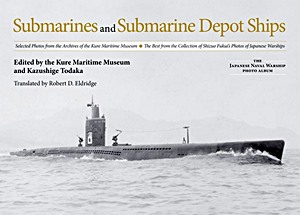Submarines and Submarine Depot Ships : Selected Photos from the Archives of the Kure Maritime Museum
Selected photos from the archives of the Kure Maritime Museum showing submarines and submarine depot ships used by the Japanese Navy.
Originally published in Japan in 2005, each album in The Japanese Naval Warship photo album series contains official photographs taken by the Kure Maritime Museum, as well as those taken by private individuals. These pictorial records document the main types of Japanese vessels, from battleships to submarines, based on the best images from Shizuo Fukui, a former Imperial Japanese Navy commander and technician.
These photos include the ones Fukui began collecting as a young boy and continued after he worked as a naval shipbuilder, and those that he was given in order to complete a photographic history of the Imperial Japanese Navy's ships, which include those gathered by Nagamura Kiyoshi, a shipbuilder who proactively collected photos, and the collection of machinist Amari Yoshiyuki. These images are especially valuable because of the massive destruction of official documents at the end of the war.
Detalles del libro
| Autor: | Kure Maritime Museum, Kazushige Todaka |
|---|---|
| Presentación: | 240 páginas, 21.5 x 30.5 x 2.3 cm, tapa dura |
| Ilustración: | abundantemente ilustrado con fotos en b/n |
| Editor: | Naval Institute Press (USA, 2020) |
| ISBN: | 9781591143376 |

Submarines and Submarine Depot Ships : Selected Photos from the Archives of the Kure Maritime Museum
Idioma: Inglés
Comprar en Amazon ESComprar en Amazon.com







